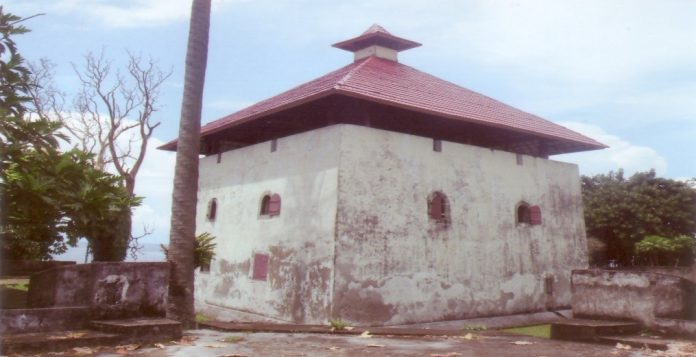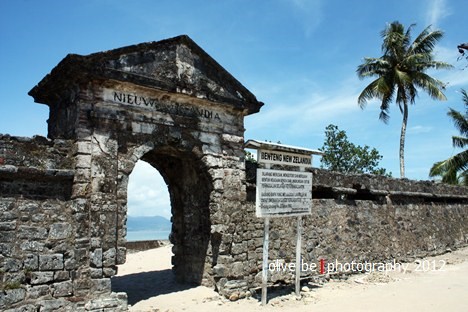
BEVERWIJK FORT IN SILA NUSALAUT

Beverwijk is located in Sila village of Nusalaut Island. The fort was founded in 1656 and by de Vlaming in 1656 it was called Beverwijk. The name Beverwijk corresponds to Arnold de Vlaming’s birthplace in Northern Amsterdam. In this fortress was placed a sergeant with 20 soldiers and a healer. The fort was armed with four cannons and was under the rule of the ruler of Honimua. In 1673 instead the sergeant was replaced by an Onderkoopman or bookkeeper. The place where the fort was built, was not rich in water so the inhabitants of the fort were forced to draw drinking water from wells dug on the beach where the steam that appeared was not good for their health.


Earlier during the time of Governor Herman Van Speult built a house in the country of Titaway, which is located on the south side of the island of Nusalaut. In 1817, when there was a popular resistance led by Pattimura, this fort was again taken from the hands of the people’s troops a few months after this. Previously during the governorship Herman Van Speult built a house in the country of Titaway located on the south side of the island of Nusalaut. In 1817 when there was a popular resistance led by Pattimura, this fort was again taken from the hands of the people’s troops a few months after this. The Beverwijk fortress is not only reminiscent of Dutch rule but also on the courage, determination and loyalty of Christina Martha Tiahahu, daughter of Paulus Tiahahu, king of Abubu, one of the leaders of the people’s resistance forces in Nusalaut. Paulus Tiahahu was executed in front of the fortress of Beverwijk on 17 November 1817, but his daughter who was involved in the rebellion was pardoned. In 1824 there were still occupying forces, and by 1838 the fort was entirely destroyed.

HISTORY OF NIEUW SELANDIA FORT IN HARUKU
Fort New Zealand is located in the land of Haruku island. The fort was ordered to be built by Arnold de Vlaming Van Oudshorn in 1655, replacing the smaller fort previously built at Oma village by Governor Jan Van Gorcum in 1626. The fort was guarded by a sergeant and 24 soldiers. The supreme ruler owned a house outside the fortress, surrounded by a wooden fence.

This fort was one of the Dutch defense bases that was attacked by the people during the Pattimura war, but was not captured. After the popular resistance ended, there was nothing left of this fortress. In 1818 a terrible storm and an earthquake destroyed it. In 1822 the fortress Nieuw Zelandia was rebuilt.
In 1862 the fort was abandoned by his troops and used as the residence of a commissioner who held supervision over the deposit of cloves. This square building is equipped with rifle holes with land and sea fortifications. Part of it collapsed and a shell shed and rear door were instead fitted with cannons. The construction is simple, two strongholds are installed facing each other, while the other corners are not equipped with reinforced ends. On the walls were installed ladders, small holes extending to facilitate fire. On the walls were installed ladders, small holes extending for rifle shots. The main gate is still in good condition, decorated with simple stucco and a memorial stone bearing the name of the fortress. On the back side is the number 1822. The fortress is rectangular in shape with a Bastion at each corner. Currently, the condition of the fort is only half left, namely the eastern part. Half of the section on the west side has been destroyed by abrasion

The fortress is rectangular in shape with a Bastion at each corner. Currently, the condition of the fort is only half left, namely the eastern part. Half of the section on the west side has been destroyed by abrasion. The Nieuw Zelandia fortress has a rectangular plan with two bastions at the southeast and northwest corners. This fort uses coral, river stone, limestone and brick as its constituent materials. The fort faces east with a gate measuring 168 cm wide and 255 cm high.
The width of the gate is 326 cm, thickness 145 cm, height 454 cm, roof length 203 cm and width 386 cm. On the inside of the fort there is a 160 cm wide porch made of new pairs.

The History of Amsterdam Fort
Amsterdam fort is located in Hila village. Previously it was a lodge then in 1637 it was converted into a stronghold when the Dutch fought against Hitu people. During the war between Hitu people and the Dutch, this fort was converted into a stronghold and expanded by Arnold de Vlamming van Ouds Hoorn. In 1649 to 1656 this fort was named Amsterdam.

The Old Church Of Hila
The old church of Hila was the former Dutch colonial heritage. This church was built as part of the spread of Crhistianity in Hila. This church was built in 1780 and finished in 1871. This church was built when Governor Bernadus Van Pleuren was Governor of Maluku. And it was named Imanuel means God is with us.





